The Most Serene House of Bourbon-Condé, named after Condé-en-Brie now in the Aisne département, was a French princely house and a cadet branch of the House of Bourbon. The name of the house was derived from the title of Prince of Condé that was originally assumed around 1557 by the French Protestant leader, Louis de Bourbon (1530–1569), uncle of King Henry IV of France, and borne by his male-line descendants.

The Palais Bourbon is the meeting place of the National Assembly, the lower legislative chamber of the French Parliament. It is located in the 7th arrondissement of Paris, on the Rive Gauche of the Seine, across from the Place de la Concorde.

The Trocadéro, site of the Palais de Chaillot, is an area of Paris, France, in the 16th arrondissement, across the Seine from the Eiffel Tower. It is also the name of the 1878 palace which was demolished in 1937 to make way for the Palais de Chaillot. The hill of the Trocadéro is the hill of Chaillot, a former village.

The Régence was the period in French history between 1715 and 1723 when King Louis XV was considered a minor and the country was instead governed by Philippe d'Orléans as prince regent.

Anne Louise Bénédicte de Bourbon was the daughter of Henri Jules de Bourbon, Prince of Condé, and Anne Henriette of Bavaria. As a member of the reigning House of Bourbon, she was a princesse du sang. Forced to marry the Duke of Maine, legitimised son of Louis XIV and Madame de Montespan, she revelled in politics and the arts, and held a popular salon at the Hôtel du Maine as well as at the Château de Sceaux.

Louis François de Bourbon, or Louis François I, Prince of Conti, was a French nobleman who became the Prince of Conti from 1727 to his death, succeeding his father, Louis Armand II de Bourbon. His mother was Louise Élisabeth de Bourbon, the daughter of Louis III, Prince of Condé and Louise Françoise de Bourbon, a legitimized daughter of King Louis XIV of France. His younger sister, Louise Henriette de Bourbon, was the mother of Philippe Égalité. As a member of the reigning House of Bourbon, he was a Prince du Sang.

Louis Joseph de Bourbon was Prince of Condé from 1740 to his death. A member of the House of Bourbon, he held the prestigious rank of Prince du Sang.

The Palais-Royal is a former royal palace located in the 1st arrondissement of Paris, France. The screened entrance court faces the Place du Palais-Royal, opposite the Louvre. Originally called the Palais-Cardinal, it was built for Cardinal Richelieu from about 1633 to 1639 by the architect Jacques Lemercier. Richelieu bequeathed it to Louis XIII, and Louis XIV gave it to his younger brother, the Duke of Orléans. As the succeeding dukes of Orléans made such extensive alterations over the years, almost nothing remains of Lemercier's original design.

Pierre Contant d'Ivry, was a French architect and designer working in a chaste and sober Rococo style and in the goût grec phase of early Neoclassicism.
Jean Aubert was a French architect, the most successful of the Régence and designer of two of the most important buildings of the period: the stables of the Château de Chantilly and the Hôtel Biron in Paris. He also created innovative interior designs, the most notable, the separation of private and public spaces for the Palais Bourbon in Paris.

Louise Henriette de Bourbon, Mademoiselle de Conti at birth, was a French princess, who, by marriage, became Duchess of Chartres (1743–1752), then Duchess of Orléans (1752–1759) upon the death of her father-in-law. On 4 February 1752, her husband became the head of the House of Orléans, and the First Prince of the Blood, the most important personage after the immediate members of the royal family.

A prince du sang is a person legitimately descended in male line from a sovereign. The female equivalent was princess of the blood, being applied to the daughter of a prince of the blood. The most prominent examples include members of the French royal line, but the term prince of the blood has been used in other families more generally, for example among the British royal family and when referring to the Shinnōke in Japan.

Louise Françoise, Duchess of Bourbon was the eldest surviving legitimised daughter of Louis XIV of France and his maîtresse-en-titre Françoise-Athénaïs, Marquise de Montespan. She was said to have been named after her godmother, Louise de La Vallière, the woman her mother had replaced as the king's mistress. Before her marriage, she was known at court as Mademoiselle de Nantes.
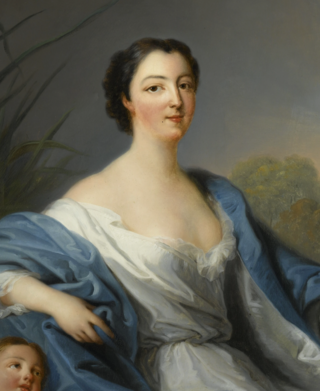
Marie Anne de Bourbon was Surintendante de la Maison de la Reine to the French queen Maria Leszczyńska. She was the daughter of Louis III, Prince of Condé. Her father was the grandson of le Grand Condé and her mother, Louise Françoise de Bourbon, Mademoiselle de Nantes, was the eldest surviving daughter of Louis XIV of France and his maîtresse-en-titre, Madame de Montespan. She was known as Mademoiselle de Clermont.
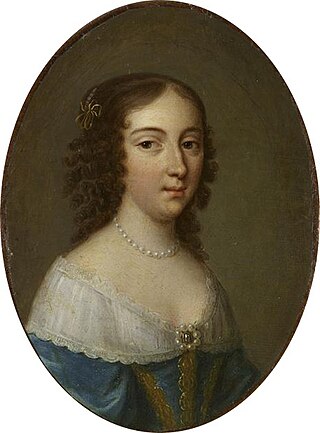
Claire Clémence de Maillé was a French noblewoman from the Brézé family and a niece of Cardinal Richelieu. She married Louis de Bourbon, Prince of Condé, known as Le Grand Condé, and became the mother of Henri Jules. She was Princess of Condé and Duchess of Fronsac.
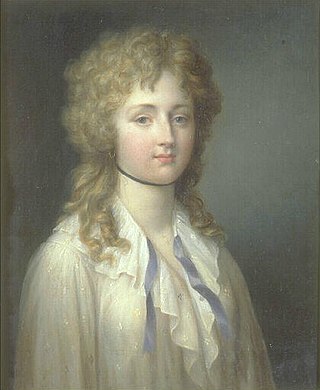
Louise Adélaïde de Bourbon was a French nun. She was the last Remiremont abbess and founded at the beginning of the Bourbon Restoration a religious community that became famous among French Catholics under the name of Bénédictines de la rue Monsieur. She constructed the Hôtel de Mademoiselle de Condé, named after her.
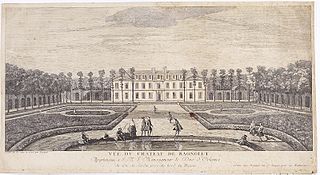
The Château de Bagnolet was a château situated in the Paris suburb of Bagnolet, France, 5.2 km from the center of the capital. The property was part of the biens de la Maison d'Orléans, private property of the House of Orléans from 1719 till 1769.
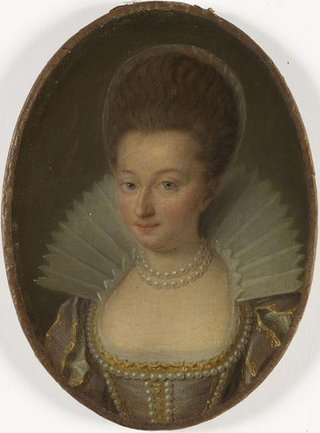
Charlotte Catherine de La Trémoïlle was a French noblewoman and, by marriage, Princess of Condé. By birth she belonged to the House of La Trémoïlle.

The Hôtel de Condé was the main Paris seat of the princes of Condé, a cadet branch of the Bourbons, from 1612 to 1764/70.
Jean-François Leroy was a French architect. For the Prince of Condé, he worked on the Château of Chantilly, the Palais Bourbon, and the Hôtel de Lassay, where he replaced Claude Billard de Bélisard in 1780.

















